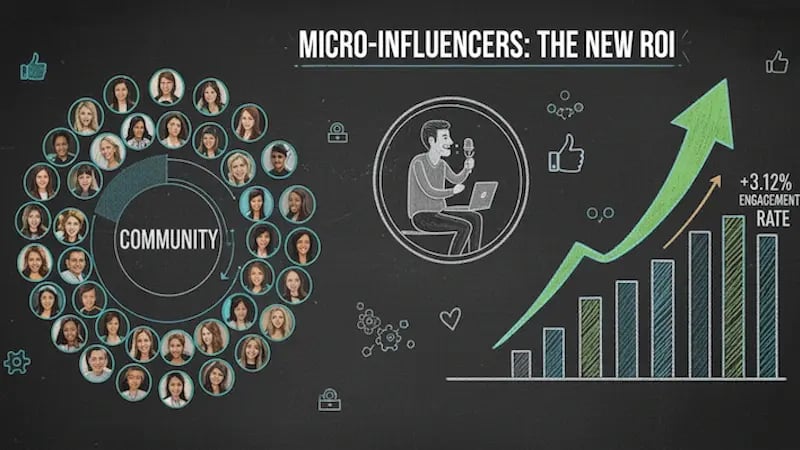Why Micro-Influencers Are Marketing's New Trust Champions
The influencer marketing game has shifted in the last few years. Big names don't mean big trust anymore. You might have noticed the change firsthand: Large influencers still pull reach, but they no longer command the kind of belief that moves deals across the line. The center of gravity has moved from star power to community power.
That's why micro-influencers now sit at the heart of a modern influencer marketing strategy focused on credibility, conversation, and compounding ROI. According to data from Clutch,
55% of consumers say they are more likely to trust micro-influencers with 10,000–100,000 followers than celebrities.
If you operate in B2B, this is good news. Instead of vying for reach based solely on popularity, you can now map influence to revenue signals. This is because micro-influencers tend to provide a deeper topic authority and closer proximity to their audience.
The Decline of the Celebrity Influencer
Trust in celebrity endorsements is fading fast. You might have seen the numbers in your own campaigns, with engagement rates dropping and conversions not being good enough. In Clutch’s surveys,
53% of consumers reported less trust when a post is paid, which explains why highly produced influencer spots can feel like just another media buy.
This cultural shift runs deeper than skepticism about paid partnerships. Most celebrity ads feel commercial, not personal. But the younger generation, especially Gen Z, prefers "real" creators who share their actual lives to some curated reels from red carpets and private jets. The further a piece of content feels from a real person, the more skepticism it attracts.
What Makes Micro-Influencers More Trustworthy?
All this comes down to what micro-influencers talk about and how they interact with their audiences.
Relatability
Younger audiences generally prefer to interact with micro creators who look and sound like the communities around them. Their feeds show actual workflows, real stacks, and honest trade-offs, far from staged set pieces.
That familiarity lowers a buyer's guard and raises the odds of real dialogue under a post, because:
-
Social media followers feel they can message them and get a response.
-
Their content maps to lived experience, such as setup videos, teardown threads, and "what I'd change" follow-ups.
-
Audiences' questions get personal answers, not canned talking points.
When audiences feel they're getting genuine attention, it further builds trust.
Authenticity
Raw, unfiltered posts build credibility in ways polished content never will.
Micro-influencers in the 10k–100k range haven't gone corporate with every post. They still share the messy middle, the failures alongside successes. That's why their endorsements read like product opinions, not scripts.
And because these creators usually grew with their audience, they protect credibility by turning down mismatched deals.
Tighter Community Connection
Small followings enable actual relationships. Micro creators also cultivate inside jokes, recurring segments, and long comment threads. Their replies carry more weight than a celebrity's polished caption, and that interaction is visible to the rest of the audience, which compounds trust.
Performance: Why Micro-Influencers Deliver Better ROI
Here are a few key reasons why micro-influencers often outperform their celebrity counterparts on ROI, too.
Higher Engagement Rates
A 2025 data analysis from Popular Pays, an influencer marketing platform, found that:
Micro-influencers on Instagram averaged a 3.12% engagement rate, compared with 1.93% for creators with 500K+ followers.
HypeAuditor's 2025 report also shows that smaller tiers, especially nano and micro-influencers, own the top engagement slots across major platforms.
What does that mean for your influencer marketing campaign? More signal in the comments, more qualified back-and-forth, and better content-market fit when you repurpose creator assets across your channels.
Better Conversions
It isn't just about likes. When creators match the niche, their audiences convert because the content answers specific questions.
A well-documented example on the B2C side is Daniel Wellington, a company that scaled by distributing budget across thousands of smaller creators, seeding product, and using trackable codes. Their playbook of volume with relevance mattered more than star cameos.
Cost-Effective Partnerships
It's true to say that in influencer marketing, fees scale with fame.
In that context, micro deals usually land at a budget you can spread across a portfolio of creators rather than a single bet. Most importantly, because these creators maintain a strong engagement with their audiences, CPMs and CPAs stay rational.
This allows you to slowly scale spend with performance and reinvest where the audience actually responds.
Long-Tail Visibility
Micro creators' tutorials, teardown threads, and walk-throughs keep picking up search and social discovery over weeks and months, especially on YouTube, because they answer precise questions. That long tail builds an asset library you can cite in sales and onboarding.
How To Find & Vet the Right Micro-Influencers
Here are a few practical tactics to find your collaboration fit.
Define Your Audience First
Lock your segmentation and buying committee details before outreach. This could include roles (e.g., RevOps leaders vs. content strategists), tech stack affinities, adjacent tools, and communities where those personas already hang out (YouTube channels, subreddits, industry newsletters, GitHub, LinkedIn groups).
Then, build a topic graph. List five to seven core use cases you want creators to cover, such as benchmarks, migration steps, and integration demos, and rank them by pipeline impact. That gives creators a sandbox that still feels natural for their audience.
Search Beyond the Obvious
Don't stop at Instagram and TikTok. For B2B, look at:
-
YouTube: Tutorials, tool comparisons, “day-in-the-life” workflows
-
LinkedIn: Niche creators who consistently drive discussion among your buyers
-
GitHub/Dev YouTube for technical products, where stars, forks, and watch-time can proxy for interest (remember to sanity-check for fake signals)
Also, scan for community-led programs in your category to reverse-engineer who already influences buyers. For example, Notion’s ambassador program grew out of its superuser base and prioritized creators who genuinely used the product.
Vet for Authenticity & Alignment
To do so, you can evaluate:
-
Audience quality: Engagement ratio, comment depth, and audience geography
-
Content relevance: Do they already teach or debate your topics?
-
Disclosure discipline: Clean ad usage and FTC compliance, protecting both sides
-
Narrative fit: Can they tell a story about problems you solve without forcing it?
Programs like Adobe Community Experts show how brands curate subject-matter leaders who educate, not just post. That posture aligns well with complex B2B motions.
Check for Red Flags
A few key red flags to watch out for are engagement spikes or sudden follower jumps with no content pattern. Comment pods (when a private group of social media users, often influencers, who agree to mutually like, comment on, save, and/or share each other's content to artificially boost their engagement metrics) and generic “great post” replies may also reveal an influencer who's not really involved with their audience.
Also, look for frequent, off-category promos that hint at low audience trust. Finally, weed out creators with anemic thread replies or no willingness to handle interactions with the audience after publishing.
In the technical world, vanity metrics (like follower count on Twitter, subscribers on YouTube, or even website traffic) are easily inflated or simply don't translate into genuine influence over buying or adoption decisions.
A large following doesn't mean developers respect the influencer's opinion on a new database or framework.
Moreover, if you're buying technical reach, it's always a great idea to cross-check vanity metrics with corroborating signals (e.g., conference talks, GitHub activity, respected newsletter features, and community engagement).
How To Build Meaningful Partnerships With Micro-Influencers
A quick bridge: One-off posts look like ads. Relationships look like advocacy.
Ditch the One-Off Post Mentality
Plan influencer campaigns as a subset of your social media content calendar, with mini editorial calendars with a creator: one deep anchor asset and several supporting cuts (shorts, carousels, threads, email snippets). That cadence gives the audience time to absorb, try, and ask for specifics.
Also, it's better not to rely on a single big campaign. Instead, combine expert contributions, social amplification, and paid/organic support to hit pipeline-adjacent metrics. That's a better template for influencer marketing in 2025 and beyond.
Collaborate on Creative
Micro creators know what their audience will watch to the end. Bring structure (briefs, key outcomes, demo access) but let the creators shape format and tone.
The best content often deviates from your original brief in the right direction. When influencers feel ownership over content, it often shows in the final result.
Offer Real Value
Cash matters, but so do:
-
Early product access for credible walkthroughs
-
Data they can reference (benchmarks, anonymized insights)
-
Distribution on your owned channels, newsletters, and events
-
Attribution support (custom UTMs, codes, landing pages)
These non-monetary benefits often matter more because they help provide tangible value to their own audiences.
Track Performance Thoughtfully
It's a great idea to map the key metrics with the following funnel stages:
-
Top of the Funnel: Qualified engagement rate (meaningful comments/views), view-through rate, time watched
-
Middle of the Funnel: Demo requests, resource downloads, community joins, email capture
-
Bottom of the Funnel: Influenced pipeline and revenue, not just last-click
You can use creator-specific UTMs and unique landing pages for precise targeting. Then, compare influencer-assisted vs. non-influencer cohorts on conversion and sales velocity across your campaigns.
Here's a simple example of how you can implement this without overhead:
-
Start with 10–15 creators across two channels where your ICP (Ideal Customer Profile) already spends time (e.g., YouTube + LinkedIn).
-
Pilot for 90 days with one anchor asset and 2–3 supporting posts per creator.
-
Instrument everything: UTMs by creator and by asset, shared dashboards, consistent post-publish Q&A blocks to harvest objections.
-
Promote the winners by placing paid ads behind top-performing creator posts and syndicating them to your newsletter, resource hub, and sales collateral.
-
Retain the best-fit creators on multi-month agreements and involve them in roadmap feedback and customer events.
This systematic approach removes the guesswork from influencer partnerships. Most importantly, it creates a repeatable process that can easily scale with your marketing goals.
The Trust Economy Demands Authenticity
Buyers don’t want yet another polished endorsement. They want people they trust to explain the trade-offs and stick around to answer questions. Micro-influencers offer that balance of reach, authenticity, and community trust your brand needs. They're not just smaller versions of celebrity influencers but an entirely different species of marketing partner.
The numbers across studies already make the case: Paid gloss alone erodes trust, while smaller, closer-to-the-work creators outperform on engagement and credible influence.
It's time to reframe influencer marketing around community. By doing so, you’ll develop a strategy that compounds with better content and conversions. The brands building meaningful relationships with the right creators, not just the biggest, will win in 2025 and beyond.
So start identifying your micro-influencer partners now. Your competitors already are. Aspiration Marketing is ready to help.
This content is also available in:
- German: Micro-Influencer: Die neuen Vertrauens-Champions im Marketing
- Spanish: Microinfluenciadores:los nuevos campeones de la confianza en marketing
- French: Micro-influenceurs : Nouveaux champions de la confiance marketing
- Italian: Micro-influencer: i nuovi campioni di fiducia del marketing
- Romanian: De ce micro-influencerii sunt noii campioni ai încrederii în marketing
- Chinese: 为什么微影响力是营销的新信任冠军?

Opinions expressed in this article are those of the guest author. Aspiration Marketing neither confirms nor disputes any of the conclusions presented.









Leave a Comment